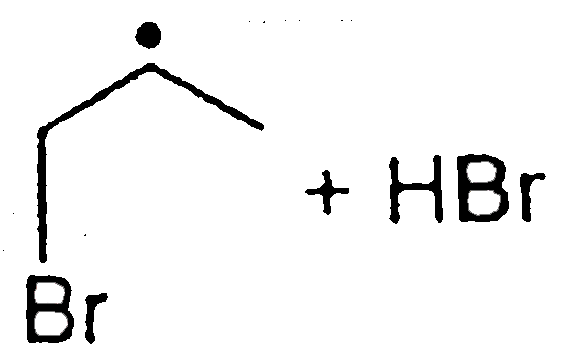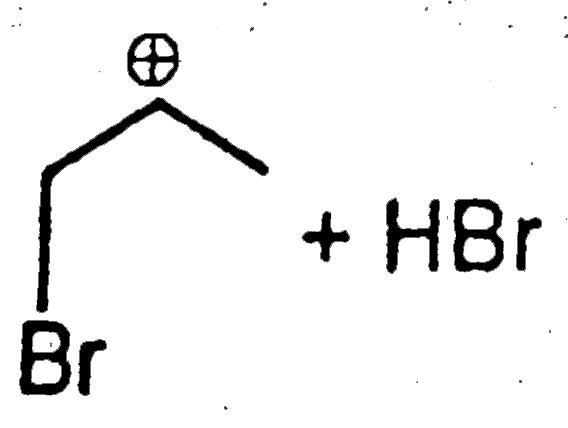Which of the following is a step in the mechanism of the reaction shown?
CH2=CH−CH3+HBrPeroxide−−−−→C∣BrH2−CH2−CH3




The correct Answer is:B
To solve the question regarding the mechanism of the reaction between propene (CH₂=CH-CH₃) and HBr in the presence of peroxide, we can break down the steps involved in the reaction mechanism.
1. Initiation Step:
- The reaction begins with the decomposition of peroxide (R₂O₂) under heat or light. This process generates two alkoxy radicals (RO•).
- Reaction:
R2O2heat/light−−−−−−→2RO∙
Hint: Remember that peroxides can decompose to form radicals when exposed to heat or light.
2. Formation of Bromine Radical:
- The alkoxy radical (RO•) then reacts with HBr, resulting in the formation of an alcohol (ROH) and a bromine radical (Br•).
- Reaction:
RO∙+HBr→ROH+Br∙
Hint: Look for how radicals interact with other molecules to form new radicals or stable products.
3. Propagation Step:
- The bromine radical (Br•) reacts with the alkene (CH₂=CH-CH₃). The Br• adds to one of the carbon atoms of the double bond, forming a more stable radical intermediate.
- Reaction:
CH2=CH−CH3+Br∙→CH2Br−CH∙−CH3
Hint: Focus on the addition of radicals to alkenes, which often leads to the formation of stable radical intermediates.
4. Formation of Final Product:
- The radical intermediate (CH₂Br-CH•-CH₃) then reacts with another molecule of HBr, resulting in the final product (CH₂Br-CH₂-CH₃) and regenerating another bromine radical (Br•).
- Reaction:
CH2Br−CH∙−CH3+HBr→CH2Br−CH2−CH3+Br∙
Hint: Consider how the radical intermediate can further react with HBr to yield the final product and regenerate the radical.
Conclusion:
The mechanism involves initiation, formation of radicals, and propagation steps that lead to the final product. The correct answer to the question regarding which step is involved in the mechanism is the propagation step where the bromine radical adds to the alkene.
- The reaction begins with the decomposition of peroxide (R₂O₂) under heat or light. This process generates two alkoxy radicals (RO•).
- Reaction:
R2O2heat/light−−−−−−→2RO∙
- The alkoxy radical (RO•) then reacts with HBr, resulting in the formation of an alcohol (ROH) and a bromine radical (Br•).
- Reaction:
RO∙+HBr→ROH+Br∙
- The bromine radical (Br•) reacts with the alkene (CH₂=CH-CH₃). The Br• adds to one of the carbon atoms of the double bond, forming a more stable radical intermediate.
- Reaction:
CH2=CH−CH3+Br∙→CH2Br−CH∙−CH3
- The radical intermediate (CH₂Br-CH•-CH₃) then reacts with another molecule of HBr, resulting in the final product (CH₂Br-CH₂-CH₃) and regenerating another bromine radical (Br•).
- Reaction:
CH2Br−CH∙−CH3+HBr→CH2Br−CH2−CH3+Br∙
The mechanism involves initiation, formation of radicals, and propagation steps that lead to the final product. The correct answer to the question regarding which step is involved in the mechanism is the propagation step where the bromine radical adds to the alkene.
Similar Questions
Identify the set of reagents/ reaction condition ‘X’ and ‘Y’ in the following set of transformations :
CH3−CH2−CH2BrX−−→ProductY−−→CH3−C∣BrH−CH3
View SolutionWhich of the following is the correct ease of dehydration ?
I CH3−CH2−CH2−CH2∣OH , II CH3−CH2−OH∣CH−CH3 , III CH2=CH−OH∣CH−CH3, IV

View Solution
Knowledge Check
Which one of the following is best catalyst for the reaction shown below ?
CH3(CH2)8CH2BrKCN−−−−−−→benzeneCH3(CH2)8CH2CNA B
B C
C D
D
Give the IUPAC names of the following compounds :CH3CH3−CH3∣C∣CHO−CH2CH3
View SolutionPh−CH2−CH=CH−CH3(i)Br2−−−−−−−−→(ii)Alc.KOH
View SolutionWrite mechanism of the following reaction:
CH3CH2OHHBr−−→CH3CH2Br+H2O
View SolutionWhich of the following is correct for
CH_(3)- CH= CH_(2) overset(HBr)underset("Peroxide")(to) ?
View SolutionWhich of the following is not the metamer of CH3CH2−N∣CH3−CH2CH2CH2CH3
View SolutionGive the IUPAC name of the following compound :
CH3−C∣CH3 = C∣Br−CH2OH
View SolutionCH3−CH2−CH=CH2+HBrROOR (peroxide)−−−−−−−−−−→(X)Major+(Y)MinorXandY respectively are
View Solution
